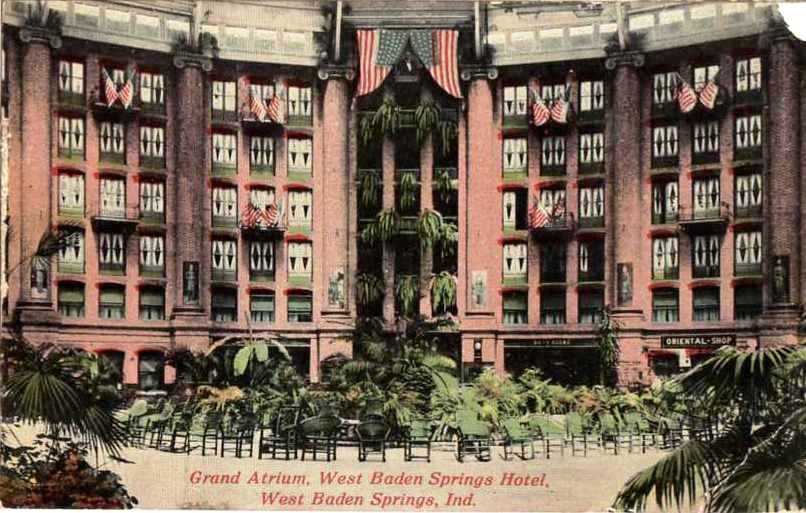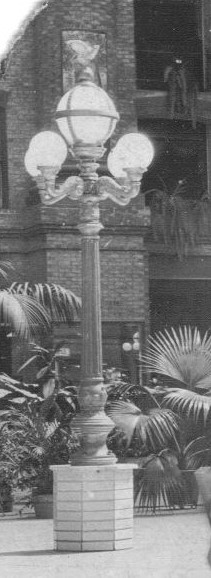This is one of those photos where there’s not a lot going on … yet there’s a lot going on.
They say a picture says a thousand words, and we tend to agree when it comes to this great historic snapshot from the earliest days of West Baden Springs Hotel. We enlisted the help of our resort historian, Jeff Lane, to tell us a little more about this awesome photo we stumbled across in our archives.

For starters, we know this photo is old, because of the austere décor — the unfinished red brick, the plain cement floor, the wicker furniture. All that received more “modern” upgrades in 1917 when Lillian Sinclair, the heiress to her father Lee’s hotel, extensively redecorated the hotel and surrounding property.
“It’s one of the earliest indoor pictures that I’ve ever seen of the atrium,” Jeff says, “because it’s before the tile floor; it’s before the brick columns were plastered; it’s before the marble was added to the walls of the first floor.”

You’ll also see artwork throughout the atrium, including portraits of men spaced out on the columns. Those are Civil War generals from a period that was relatively recent: the end of the Civil War would have been about 45 years prior to this photo being taken. And what’s the deal with the bounty of plant life in the atrium?
“I was under the impression that when Lee Sinclair was still alive, he had a plant on the property from every state in the union. (46 states, at the time, assuming it’s 1910 — New Mexico, Arizona, Alaska and Hawaii were not yet states.) Any plant that would not have survived outside would have been inside the atrium – so that’s why you would have had palm trees. You see lots of palm or ferns or plants with fronds.”

The seal fountain, after being located to the brick drive outside the hotel.
Look between the man and the girl standing, and on the floor behind them is the “seal fountain” that was once a visual centerpiece of the atrium. Named for its seal figure in the center of the fountain, this was removed from the atrium a few years later and relocated to the brick drive outside the hotel. The fountain is still there today — minus the seal, which was lost at some point long ago.

There were likely a few of these light fixtures in the atrium, with four small bulbs, one large bulb and an eagle figurine atop it. There may have been an additional light source in the dome and possible small table lamps throughout the atrium, but these were the main light source.
“It was before the Bacchus lights were added beneath each one of the columns, so your light fixture is right there in the atrium,” Jeff says.
These interior light fixtures were similar to the old light fixtures that once adorned the front drive and arched entryway (pictured below).


Look closely in the center of the photo, and you’ll see a grandfather clock along with what appears to be a curio cabinet. It’s something we don’t think about today as a glance at our cell phone tells us the time, but back then, clocks in public spaces were a necessity. The curio cabinet may have been associated with one of the shops that faced the atrium. And we know which direction in the atrium this was shot, since the entryway is labeled “Springs.” Today, as you can see in the present-day photo, this is labeled “Mineral Springs,” and this would take you to the garden area.

What about the people in this photo? We’re guessing they took this snapshot in the summer, since some of them are in short sleeves and the man on the left has a light suit — wearing a light-colored suit in cold-weather months was fashion faux pas. From the suits to the pins and hats worn by the ladies, visiting West Baden meant dressing for the occasion.
“I would say those are some of their better clothes – they, I think, know their photo is being taken. It’s not just a random shot. They know that they’re being photographed. And we know the hotel had a photographer — he might have seen this family or group and asked to take their photograph.”
And it’s not shoddy camera work making a few of these faces blurry. Early cameras had a very slow shutter speed, so subjects needed to sit still for long periods of time for the image to come out crisp. (It’s also why people during this time usually had stoic expressions, because stillness was serious business.)
“The man on the left may be rocking back and forth, and of course you couldn’t keep the baby still, so the faces look a little bit blurry,” Jeff says. “But that’s still an awesome photo.”
Indeed it is. One thing we’re not sure of? That sign on the far left. The small words read “breaks within” and the large letters make up a word ending in “ructo.” We know a drug store was located in this area, so maybe this was promoting some type of wellness product? Hard to say for sure, but a little mystery only adds to the charm of this snapshot of a bygone time.